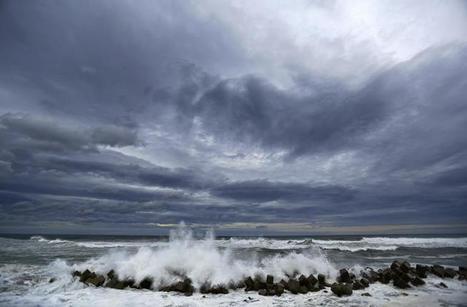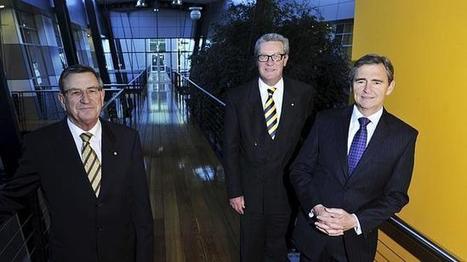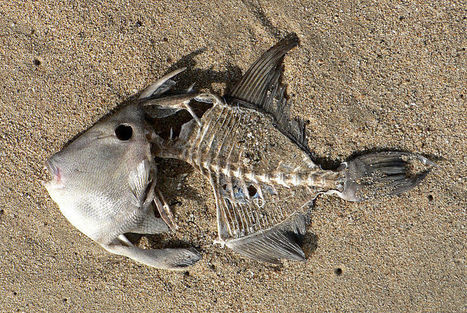 Your new post is loading...
 Your new post is loading...
17,000 gallons of crude oil spilled from an eight-inch pipeline owned by Koch Pipeline Company on Tuesday, the Railroad Commission of Texas reportedWednesday.
The spill impacted a rural area and two livestock ponds near Smithville and was discovered on a routine aerial inspection, according to the Austin American-Statesman.
Details are scarce regarding the cause of the spill and cleanup measures underway but, as UPI reported, “Koch Pipeline Co. said it notified the appropriate federal and state regulators but had no estimated time for repairs. Neither Koch nor the Texas Railroad Commission had a public statement about the incident.”
According to its website, Koch Pipeline Company, L.P. is an indirect, wholly owned subsidiary of Koch Industries, Inc., the company controlled by billionaire petrochemical giants Charles and David Koch. Koch Industries has also come under fire recently for dumping petroleum coke, a byproduct of tar sands refining, along riverfronts in both Detroit and Chicago.
Click headline to read more--
After a five-year battle by Access Info Europe, Europe's highest court has made an important ruling that will help boost transparency in the European Union:
the European Court of Justice today rejected arguments by the Council of the European Union that it should be able to keep secret the identities of Member States making proposals in the context of negotiations on future EU legislation.
The Council of the European Union had fought to defend its policy of releasing legislative drafting documents with the names of Member States tabling amendments blacked out.
"Access Info Europe won access to the document it requested before the General Court in March 2011 but the Council appealed, joined by the Czech Republic, France, Greece, Spain and the UK."
The Council of the European Union is one of three bodies that jointly run the European Union, along with the European Parliament and European Commission. Some countries wanted their names blacked out from official Council of the European Union documents because it would have revealed which of them had blocked or tried to water down proposals they were hostile to. Now that it will be possible to name and shame Member States that act in this way, they will probably be less willing to be seen objecting to important and popular measures.
As Access Info Europe explains:
Click headline to read more--
Internet giant Google has sought to dispel what is says is a "myth" that consumers don't want, won't pay for or don't need high-speed, gigabit broadband.
Speaking at the Broadband World Forum in Amsterdam on Tuesday, Kevin Lo, general manager of Google Fibre, said he'd heard the argument bandied around about broadband circles "quite a bit" but that it wasn't true. He based his assertion on Google's recent foray into building privately backed gigabit fibre-to-the-premises networks in Kansas City; Austin,Texas; and Provo, Utah, in the US.
"I can say with full confidence [it] simply isn't true," he said. "There is huge consumer demand... for faster internet and we believe that faster internet speeds will lead to what we call the next chapter of the internet."
"We're confident that the next 100x improvement in speeds will lead to more innovation... and our goal at Google is really to give our users and entrepreneurs alike ubiquitous access to high-speed broadband.
"And we know that they will rise to that occasion and build those next set of gigabit applications that we can't even imagine at this point."
His comments came as NBN Co, the company charged with rolling out Australia's national broadband network, begins trialling technology to connect apartments and other multi-dwelling units, such as shopping centres, to its network "node" using a building's existing copper wiring. At present, the fibre-to-the-basement technology can't deliver gigabit speeds, though this is likely to change with the advent of VDSL coupled with vectoring technology.
The new Australian government has based its broadband policy on the assertion that lower broadband speeds would fulfil most users' needs and could be delivered faster and cheaper. It has opted for fibre-to-the-node plus existing copper to the premises for the majority of the population, instead of Labor's original fibre-to-the-premises network.
Click headline to read more--
We’re big fans of shipping container-based architecture here at Gizmag, and the latest such project to grab our attention comes via JYA-RCHITECTS and its Low Cost House. The budget-friendly dwelling features three shipping containers placed within a surrounding structure in order to provide a safe and attractive home for a family of seven.
Based in a small rural village in South Korea, the Low Cost House is the second in a series of inexpensive homes from JYA-RCHITECTS to be sponsored by the Korea Child Fund in a bid to improve the living conditions of low-income families.
Though the plot originally held a previous property, it was in such a state of disrepair – and so blighted by rats – that any notion of undertaking a renovation was sensibly jettisoned in favor of a fresh start.
Click headline to read more and view pix--
In 2007, mathematicians from the University of Exeter showed that the freeway traffic jams that appear to occur for no reason are actually the result of a "backward traveling wave" initiated when a driver slows below a critical speed. This sets off a chain reaction that ultimately results in traffic further down the line coming to a complete standstill. An MIT professor has now developed an algorithm that could be applied to a modified Adaptive Cruise Control (ACC) system to help eliminate such traffic jams.
Last year, Honda announced plans to conduct public-road testing of technology that detects whether a person's driving style is likely to create traffic jams and encourages them to adopt a driving style that would avoid this. At the time, Honda said it would be possible to further improve this system by connecting it to cloud servers that would allow a vehicle's ACC system to automatically sync with the driving patterns of vehicles further up the road.
Berthold Horn, a professor in MIT’s Department of Electrical Engineering and Computer Science, has come up with a somewhat similar approach that would also rely on a vehicle's ACC system, but without the need for the system to connect to the cloud. However, it would require current ACC systems, which only monitor the speed and distance of vehicles in front, to be modified to also take into account the speed and distance of the vehicle traveling directly behind.
Click headline to read more--
As a European, I’ve always been struck by the harsh reality that our region of the world has so much going for it in terms of ideas and intellectual property and sheer inventiveness, but has tragically lacked the necessary support from investors and from the market to become a tech powerhouse.
For decades the way for a European tech company to thrive was to fly under a flag of convenience in the US. I recall the days (far too long ago now for comfort) of one UK-based company that managed to make inroads into the US corporate market, but only by pitching itself as a Dallas-based firm to the IT decision makers and the media.
We can argue that SAP breaks the rules here, although the company’s joint-citizenship as US and German firm perhaps challenges that argument, and of course there are exceptions out there.
For example, UK firm Huddle is doing rather nicely in the US federal government market right now for instance, but it remains a rare example of such a phenomenon. More typically tech market dominance travels east from the US to Europe rather than the other way around.
And so we get those who bemoan US dominance of the technology markets in Europe and urge the miraculous creation of a domestic industry to counter what they see as a stranglehold on the region.
Problem One: there’s a perilously fine line between championing the European economy as a potential global powerhouse and coming across as jealous of the success of the US technology marketplace.
Problem Two: Problem one has some very powerful advocates.
Click headline to read more--
Bitpay, a company that lets businesses accept payments in the Bitcoin virtual currency, has just processed its first US$1 million transaction.
The money was spent on new bitcoin mining hardware sold by Butterfly Labs, a company in Kansas City that makes specialized computers used to unlock new bitcoins and help manage the bitcoin network, Bitpay said on Tuesday.
The order was only a down payment on a forthcoming order, which will be worth more than the million dollars just spent, said Jeff Ownby, a spokesman for Butterfly Labs.
It was placed by a U.S. corporation that's an existing Butterfly customer, Ownby said. Butterfly will disclose the customer's identity in the next day or so, he said, but Butterfly appeared to have been caught off guard by Bitpay's announcement and wasn't prepared to do so yet.
Bitcoin is a digital currency used to make payments over the Internet. It works on a peer-to-peer network and exists outside the control of traditional financial institutions.
When the Bitcoin system was set up, its creator designed it so that new bitcoins could be "unlocked," or introduced into the system, at a fixed rate over a period of time. Unlocking the bitcoins involves solving complex cryptographic algorithms, and a cottage industry has sprung up around "mining" new units of the currency.
Click headline to read more--
China’s top commercial diplomat has warned that continued limits on technology company Huawei’s operations could discourage other Chinese companies from investing in Australia, as Opposition Leader Bill Shorten joined the security row by demanding briefings from intelligence chiefs.
Peng Gang, the Sydney-based Economic and Commercial Consul, said Chinese companies invested overseas based on commercial principles and there were a lot more “outstanding companies like Huawei” which wanted to invest in Australia. He said Chinese companies would go to countries which gave them the best opportunities and prospective Chinese investors would be looking for fair treatment.
He told the Sydney China Business Forum the Huawei issue was “a very important step to co-operation down the track” because the prospects for increased trade and investment between the two countries was large. Controversial Chinese technology vendor Huawei was banned by Labor from supplying the national broadband network on the advice of intelligence agencies.
The comments from China came as Mr Shorten demanded top-level briefings from Australia’s intelligence chiefs on the safety of letting Huawei onto the NBN.
Communications Minister Malcolm Turnbull has flagged a review of the ban with the possibility of relaxing it.
Click headline to read more and watch video clip--
Aquatech Amsterdam is much more than just an exhibition. The event provides a comprehensive overview of the market and the latest trends and developments. Educate yourself at the AquaStages The exchange of know-how and experience is a key part of Aquatech Amsterdam 2013.
For the 4th time the show is featuring the AquaStages. Based on the exhibition floor, three stages will host seminars, workshops and lectures. The stages will be interactive meeting points where exhibitors can present new solutions in various fields. During the presentations one can meet suppliers and discuss the proposed solutions.
International Water Week International Water Week Amsterdam is the largest water event in Europe dedicated to integrated solutions covering the entire water cycle. This year's theme is: Integrated water solutions for a green economy. Read more on the International Water Week website >>
Click headline to read more--
At least 13 people were killed and thousands of homes left without power in the worst storm to hit northern Europe in a decade.
Hurricane-force winds and heavy rain brought down trees and powerlines, causing severe travel disruption with trains, flights and ferries being cancelled and major roads closed.
A 17-year-old girl was killed when a tree fell onto a caravan in Kent, while a man was crushed to death when a tree fell onto a car in north London.
A man and a woman died in west London when a tree fell onto a house, causing a suspected gas explosion and three properties to collapse
Six people were killed in Germany - four by trees falling onto cars and a fisherman and a sailor were killed in separate incidents at sea, the BBC reported.
A woman was swept out to sea in northern France, and a tree crushed a woman near a canal in Amsterdam.
Click headline to read more and watch video news clip--
The March 2011 crisis at the Fukushima nuclear power plant was the world's worst nuclear disaster since Chernobyl in 1986, but it took two and a half years after the fact for the Japanese government to ask the world for help.
On Sunday, Prime Minister Shinzo Abe said Japan is finally open to receiving global aid to contain the ever-growing disaster at Fukushima, where radioactive water leaks continue to contaminate the Pacific Ocean’s ecosystem, and thus, the entire world’s food supply.
"We are wide open to receive the most advanced knowledge from overseas to contain the problem," Abe said, in English, to open a conference on energy and the environment at an international science forum in Kyoto. “My country needs your knowledge and expertise.”
Abe has many times attempted to assuage national and international concerns. After Tokyo was named host in early September for the Summer Olympic Games in 2020, Abe repeatedly told the International Olympic Committee that the Fukushima situation “is under control.”
Click headline to read more--
China’s top commercial diplomat has warned that continued limits on technology company Huawei’s operations could discourage other Chinese companies from investing in Australia, as Opposition Leader Bill Shorten joined the security row by demanding briefings from intelligence chiefs.
Peng Gang, the Sydney-based Economic and Commercial Consul, said Chinese companies invested overseas based on commercial principles and there were a lot more “outstanding companies like Huawei” which wanted to invest in Australia. He said Chinese companies would go to countries which gave them the best opportunities and prospective Chinese investors would be looking for fair treatment.
He told the Sydney China Business Forum the Huawei issue was “a very important step to co-operation down the track” because the prospects for increased trade and investment between the two countries was large. Controversial Chinese technology vendor Huawei was banned by Labor from supplying the national broadband network on the advice of intelligence agencies.
The comments from China came as Mr Shorten demanded top-level briefings from Australia’s intelligence chiefs on the safety of letting Huawei onto the NBN.
Communications Minister Malcolm Turnbull has flagged a review of the ban with the possibility of relaxing it.
Click headline to read more--
So what is with all the dying bees? Scientists have been trying to discover this for years. Meanwhile, bees keep dropping like... well, you know.
Is it mites? Pesticides? Cell phone towers? What is really at the root? Turns out the real issue really scary, because it is more complex and pervasive than thought.
Click headline to read more--
|
Bitcoin shares with drones the unhappy distinction of being the subject of almost exclusively negative reports. Just as drones are usually doing bad things to people, so Bitcoins are usually helping people do bad things because of their supposed untraceability. So it makes a pleasant change to come across an upbeat Bitcoin story like this, as told by the Guardian:
Kristoffer Koch invested 150 kroner ($26.60) in 5,000 bitcoins in 2009, after discovering them during the course of writing a thesis on encryption. He promptly forgot about them until widespread media coverage of the anonymous, decentralised, peer-to-peer digital currency in April 2013 jogged his memory.
In those four years, his Bitcoin holding had become worth around $886,000 -- a rather nice gain on the original outlay. But the real moral here is not, as it might appear, that you should rush out and buy Bitcoins in the hope that they will be worth fabulous sums in a few years' time -- the continuing fluctuations in Bitcoin's value and doubts about its underpinnings make that a very risky proposition. Rather, the key thing to note is the following:
Click headline to read more--
Li-Fi, an alternative to Wi-Fi that transmits data using the spectrum of visible light, has achieved a new breakthrough, with UK scientists reporting transmission speeds of 10Gbit/s – more than 250 times faster than ‘superfast’ broadband.
The fastest speed previously reported was 3Gbit/s, achieved earlier this year by the Fraunhofer Heinrich Hertz Institute in Germany. Chinese researchers also claimed this month to have produced a 150Mbp/s connection, but some experts were doubtful without seeing further proof.
The term Li-Fi was coined by Edinburgh University's Prof Harald Haas during a TED talk in 2011 (see below for video) though the technology is also known as visible light communications (VLC).
Many experts claim that Li-Fi represents the future of mobile internet thanks to its reduced costs and greater efficiency compared to traditional Wi-Fi.
Both Wi-Fi and Li-Fi transmit data over the electromagnetic spectrum, but whereas Wi-Fi utilises radio waves, Li-Fi uses visible light. This is a distinct advantage in that the visible light is far more plentiful than the radio spectrum (10,000 times more in fact) and can achieve far greater data density.
Li-Fi signals work by switching bulbs on and off incredibly quickly – too quickly to be noticed by the human eye. This most recent breakthrough builds upon this by using tiny micro-LED bulbs to stream several lines of data in parallel.
Click headline to read more--
Researchers at one of the world’s oldest universities, Cambridge, have come up with a prototype for a possible future internet infrastructure that does away with the need for servers. This could help solve the network capacity problems that arise out of the profusion of bulky online content such as video.
The way the internet currently works, content is mostly delivered to client devices such as PCs and smartphones from powerful computers called servers, which are generally housed in data centers. This represents a centralization of computing power and storage that some argue is becoming outdated, what with the beefy processors and (sometimes) capacious storage devices we carry around in our pockets these days.
The Cambridge University prototype would represent a dramatic revamp of that way of doing things. Part of a wider EU-funded project called Pursuit, the putative protocol operates more like the popular filesharing mechanism BitTorrent, in that users share information directly with one another, rather than through a server. Simplistically put, Person B might receive content from Person A’s device, then become a source for that data so Person C could then download it, and so on.
Fragments of the same data might be replicated all over the place, in order to make re-assembly as quick and efficient as possible. So, for example, if you want to watch a TV show online, you would get its fragments from people nearby who have already downloaded and watched it, rather than from the provider’s server or content delivery network.
Click headline to read more--
After the credit crisis and Great Recession, it seemed ridiculous to have thought that investing in subprime mortgages was a good idea. As with most market "bubbles," the risk of giving 7.5 million mortgages to people who couldn't possibly pay them off was somehow invisible to many investors at the time.
One reason such bubbles form is the tendency by many investors to confuse "risk" with "uncertainty." As the economist Frank Knight established, there is a subtle but crucial distinction between the two: Uncertainty is what good investors usually fear the most, because it cannot be measured or priced as risk can be. But when investors mislabel risk as uncertainty, they become vulnerable to the assumption that since it cannot be measured, they might as well ignore it.
That is exactly what is happening with the subprime carbon asset bubble: It is still growing because most market participants are mistakenly treating carbon risk as an uncertainty, and are thus failing to incorporate it in investment analyses. By overlooking a known material-risk factor, investors are exposing their portfolios to an externality that should be integrated into the capital allocation process.
Click headline to read more--
Hardly anybody fully grasps how the internet works. Even Google's executive chair wrote in his book The New Digital Age, "The internet is among the few things humans have built that they don’t truly understand."
But here's an attempt: It consists of tens of thousands of interconnected networks run by service providers, individual companies, universities, and governments. There are three major parts to its construction: the networks that physically connect to each other (with about 12 that are particularly significant); the data-storing centers; and the architecture that lies in between. That is where it gets really interesting.
There are more than 550,000 fiber optic cables laid along the ocean floor that transmit trillions upon trillions of interactions per day. According to the Washington Post, these cables "wrap around the globe to deliver emails, web pages, other electronic communications and phone calls from one continent to another."
These utterly phenomenal underwater and long-haul fiber optic cables send information from virtually any point in the world to another at the speed of light — 186,000 miles per second. The circumference of the Earth is only 24,000 miles at the equator, which means these messages could technically circle the globe about eight times in one second. All from the bottom of the ocean.
Connections around the world are now run primarily on these undersea cables that link every continent and most island nations, with the exception of Antarctica. Here are some images of them.
Click headline to read more and view maps--
An Informa Telecoms & Media study conducted on behalf of the Broadband Forum indicates that a majority of carriers view interoperability and certification of GPON gear will prove essential for the fiber to the home (FTTH) technology’s future prospects.
Perhaps not coincidentally, the Broadband Forum offers both an interoperability test plan and a GPON interoperability certification program.
Informa released the study results last week in a report entitled “Optimizing the Fiber Business Case.” The market research and consultancy firm surveyed 237 broadband industry “stakeholders” and interviewed senior executives at Orange, BT, Chunghwa Telecom, PCCW, Alcatel-Lucent, Calix, Huawei, and PT Inovacao. The report includes case studies culled from these interviews.
Both Informa and the Broadband Forum expect GPON will become the dominant FTTx access technology in 2016, passing 200 million connections in 2018 to account for three out of five FTTx connections worldwide. However, interoperability issues between different vendors’ OLT and ONU equipment has caused an array of problems for many service providers and need to be addressed if GPON is to fulfil its promise, the report suggests.
Key findings of the report include:
Click headline to read more--
Why is there so much death and disease among sea life living near the west coast of North America right now? Could the hundreds of tons of highly radioactive water that are being released into the Pacific Ocean from Fukushima every single day have anything to do with it?
When I wrote my last article about Fukushima, I got a lot of heat for being “alarmist” and for supposedly “scaring” people unnecessarily. I didn’t think that an article about Fukushima would touch such a nerve, but apparently there are some people out there that really do not want anyone writing about this stuff.
Right now, massive numbers of fish and sea creatures are dying in the Pacific Ocean. In addition, independent tests have shown that significant levels of cesium-137 are in a very high percentage of the fish that are being caught in the Pacific and sold in North America.
Could this have anything to do with the fact that the largest nuclear disaster in the history of mankind has been constantly releasing enormous amounts of radioactive material into the Pacific Ocean for more than two years? I don’t know about you, but to me this seems to be a question that is worth asking.
Since I wrote my last article, major news outlets have reported that large numbers of sea stars living off of the west coast of North America appear to be “melting“…
Click headline to read more--
Michigan may be the Great Lakes state, but its neighbors to the east and west are leading efforts to turn water-based technology, academic research and tourism into jobs and revenue.
Milwaukee and the province of Ontario are well ahead of Michigan’s efforts to capitalize on an $850 billion global freshwater economy, according to John Austin, hired by the state last year to shepherd its so-called blue economy.
“Michigan needs to catch up and leapfrog states and communities vying for the prize of water technology, research and education leadership, and who are marketing their water-based natural assets and sustainability/lifestyle ‘brand,’” Austin said in a report commissioned by Gov. Rick Snyder’s Office of the Great Lakes.
Austin, who is director of the Michigan Economic Center at the Ann Arbor-based Prima Civitas Foundation, said Michigan has all the assets necessary to support a thriving blue economy: abundant freshwater, a growing tourism industry, world-class research universities focused on water issues, and manufacturers capable of turning innovative concepts into marketable products.
Michigan ranked 12th nationally in the number of green (environmentally friendly) jobs in 2010, according to the U.S. Bureau of Labor Statistics. Austin said Michigan could and should be a leader in the blue economy. “We know the economic development payoff of water restoration and water-based development efforts is tremendous,” Austin said. “Michigan needs to get its share of this market.”
Globally, spending on water-related technology and water shortage solutions is expected to reach $1 billion by 2020.
Click headline to read more--
If you read this site you know that water is a major issue and how we relate to and manage our water could be the defining issue of the 21st century. Water innovation is just now starting to build buzz and attract investors, with venture capital still not flush and technologies very much in their infancy. Any discussion of macro-water issues brings up the smart water grid as a necessary but complicated step- but will smart water grids, currently a $530 million market, become a $16.3 Billion industry in the next ten years? A new report from Lux Research thinks it will.
According to Lux, the smart water grid market could balloon over the next ten years as it becomes increasingly important and draws both investment and innovation. Lux identifies 5 areas of the smart water grid, saying that start-up ventures will be most successful if they can integrate them in an innovative fashion: water mapping, water infrastructure, water quality monitoring, smart meters and smart irrigation.
The new technology and innovative management ideas around water from desalination plants and water footprint accounting are starting to catch the eyes of big businesses and investors. According to Drew Clark, Venture Capital Group Director of Strategy at IBM, said that factors from the Obama administration’s environmental stimulus money has created the perfect storm for water-focused start-ups and the development of a smart grid.
Click headline to read more--
It looks like Glenn Greenwald picked the right time to leave the UK's The Guardian newspaper. Last week, we noted that David Cameron was pushing for an investigation into the paper for publishing stories based on Ed Snowden's leaks, and now Cameron is going even further in his attempt to stomp out any sense of a free press in the UK, threatening to make moves to block UK publications from writing anything else new about as-yet-unreleased Snowden documents. Because that'll stop the outrage.
David Cameron threatened on Monday to act to stop newspapers publishing what he called damaging leaks from former U.S. intelligence operative Edward Snowden.
"If they don't demonstrate some social responsibility it will be very difficult for government to stand back and not to act," Cameron told parliament.
I love that phrase "social responsibility." Because an awful lot of people would argue that the Guardian has demonstrated a hell of a lot more "social responsibility" in publishing the stories they have, revealing the massive overreach of the NSA, GCHQ and others in violating the civil liberties of people around the globe.
Later in his talk, Cameron suggests that he doesn't want to have to take direct action -- which is an implication that he might do exactly that:
Click headline to read more--
No, the idea isn’t to power commercial air travel with photovoltaic solar – that’s being left that to super-lightweight, experimental efforts like Solar Impulse.
Nevertheless, a French collaboration this week plans to unveil a new way of bringing solar power to aircraft, with a photovoltaic window. The pitch is that it can automatically adjust the amount of light shining into the airplane without any complicated connection to the plane’s electrical system, while also potentially producing and storing energy that can be used for lighting and charging.
Click headline to read more--
As noted in a recent post, Orange County hosted the U.S. Department of Energy's biennial green building event the Solar Decathlon this year, constructing a village of 'solar homes' in Irvine's Great Park, open to the public two weekends in October.
The twenty student-built projects compete in ten contests with specific criteria, ranging from architecture and engineering to communications and energy balance. The individual contest scores are totaled at the end of the competition to determine overall livability, efficiency and affordability, awarding the team with the highest overall score first place.
Click headline to read more and view pix--
|



 Your new post is loading...
Your new post is loading...





























